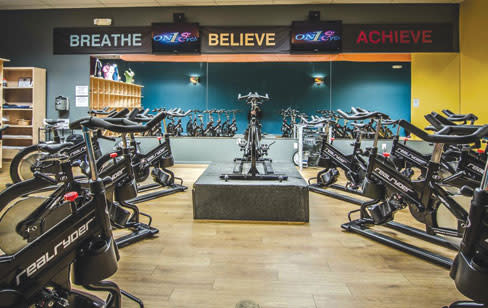Sarasota Health News: December 2013

The Pharmacist: "Use Us."
Third-year LECOM pharmacy student Michelle Sampson on drugs, genetics, and the role of pharmacists in today's health care.
A job in a Sam's Club pharmacy led Michelle Sampson, 25, to develop a passion for the pharmacist/patient relationship. "Trust is such a huge thing," she says. "Just knowing that we're there for them, watching their medications and monitoring their health." This summer, Sampson completed a pharmaceutical internship at the Walmart/Sam's Club headquarters in Bentonville, Ark., and is now in her third and final year at the LECOM School of Pharmacy in Bradenton.
Pain medication is a hot topic now. How does that affect pharmacists?
It's pretty crazy how manufacturers are trying to crack down, limiting the amounts that pharmacies can get. It's sad for the people who really need it.
It's important that [pharmacists] do ask about the patient's condition. If it's a cancer patient from Moffitt, this patient is definitely in need. If someone comes with chronic back pain, they've been on [pain medication] for years and their dosage keeps going up, we ask, What can we do to get them off of these drugs? If patients aren't open to that, it might make us question, Do they really need it? Are they addicted?
A lot of it is up to the doctor. The pharmacist will often call the physician to verify. If it's a new patient, it's pretty much mandatory [to call], just to make sure.
What role do genetics play in the pharmacy industry?
Right now we're studying different genotypes that affect how people metabolize drugs differently. There's so much variability out there; if we study this stuff more, we could figure out how to have different outcomes [from different medications].
One example is CYP enzymes. If you underexpress [under-produce] CYP3A4 gene, and you take codeine, then it can be metabolized to morphine. So you can get toxic levels of morphine in your body. If you overexpress that gene, the codeine might not be as effective.
A lot of drugs now recommend that you have genetic testing, just to be sure you're going to metabolize it properly.
Beyond filling prescriptions, how can pharmacists help their patients?
Medication Therapy Management (MTM), which means going through patients' whole health history and their current medications. I feel like everybody needs to have an MTM session, to see if drug interactions are OK. You can set an appointment at most pharmacies, or just walk in.
In fact, a lot of people don't even take their medications correctly, don't follow the instructions. Some things are really hard—you might have to take three in the morning and three in the evening, then two the next week, then one the following week. Believe it or not, a lot of people are not taking medications with meals when they're supposed to. Birth control—a lot of girls don't know that they need to take them the same time every day. Antibiotics—you have to make sure you take the entire bottle. They just never learned these things.
What should people know about pharmacists?
The role of the pharmacist is expanding. It would be great if more people knew that they could come to us for different types of counseling. Use us. We're not just counting pills. We're very clinical. We're easy-access health care.
"Use us. We're not just counting pills. We're easy-access health care."
You Are Getting Very Healthy…
You know you want to be healthier, so why aren't you? The answer may not be a lack of willpower, says noted Sarasota weight-loss counselor and hypnosis expert Rena Greenberg. Sometimes, our conscious efforts are no match for—and can even get in the way of—our subconscious programming.
Inspired by her own experiences with biofeedback therapy and self-hypnosis, Greenberg has been conducting hospital-sponsored weight-loss hypnosis programs for more than 20 years. The idea is to escape from conscious chatter and access the subconscious programmingthat's running underneath a lot of our behaviors. That programming may be negative messages—You're not good enough; you're not going to measure up—or just long-obeyed feelings of obligation—Finish everything on your plate; have some cookies and milk when you're upset.
"Hypnosis is a natural state," says Greenberg, citing common hypnosis-inducing activities like driving on the interstate or even reading a book—what other people might call "zoning out."
It's during that state, after having spent time determining your thought pattern, that Greenberg can make suggestions for healthier subconscious impulses. During gastric bypass hypnosis, for instance, she asks the patient to imagine feeling as if there's a band on his stomach that only allows him to eat five or six or seven spoonfuls at a time. The process creates a subconscious message to trigger a physical state—which, really, is also what's happening when your body seems to be telling you it's craving cupcakes. Change the message, and a change in behavior follows naturally.

Spotlight: On1 Cycle
What: Indoor stationary cycling studio
Where: 5573 Palmer Crossing Circle, Sarasota
How it works: A variety of trainer-led indoor cycle classes, from traditional to abbreviated to combinations like "Yoga Ryde" or "Kettle and Pedal."
Why it's different: On1 uses top-of-the-line RealRyder ABF8 cycles, what On1 founder Reid Winslow calls "the Maserati of indoor bikes." RealRyders can lean forward, backward and side-to-side in imitation of actual road biking conditions, engaging your core (in addition to your legs) and burning up to 40 percent more calories an hour.
What's new: This fall, Winslow introduced intimate, eight-person barre classes at the facility. He's considering launching combination cycle classes and calling them "biker barre."
Click here to read Hannah Wallace's Health & Fitness blog. >>
This article appears in the December 2013 issue of Sarasota Magazine. Like what you read? Click here to subscribe to Sarasota Magazine. >>



